Agricultural Heritage Landscapes of Greece: Three Case Studies and Strategic Steps towards Their Acknowledgement, Conservation and Management
Abstract
1. Introduction
2. Materials and Methods
- Landscape character and guidelines
- Landscape quality and strategies
- Landscape value and designation
- Landscape sensitivity and capacity
2.1. Case Study 1. Masticulture Landscapes in Chios Island, North Aegean Region
2.2. Case Study 2. Black (Corinthian) Raisin Vineyards in Aigialeia (Egialia), Achaia Region, Peloponnese
2.3. Case Study 3. The Olive Groves of Thassos Island, Kavala Region, Macedonia
3. Results—Discussion
- Adopt a holistic approach in safeguarding the landscape that is interrelated with the masticulture and has been formed by it, rather than safeguarding individual elements or aspects of masticulture (as has been the practice to date).
- Safeguard and support at a global scale the ALH value and the masticulture as a ‘system’ with great ecological and social benefits, ecosystem services and tradition identity.
- Encourage the research, conservation and promotion of the history and culture associated with the masticulture.
- Highlight the benefits of masticulture in supporting sustainable agriculture and rural development of local communities and the opportunities for supporting agrotourism, cultural and gastronomic tourism while concomitantly protecting both the masticulture landscape and heritage.
- Include the cultivation of black raisin of Aigialeia in the Intangible Cultural Heritage of Greece.
- Encourage the research, conservation and promotion of the history and culture of the Corinthian raisin and its traditional cultivation methods.
- Expand raisin cultivation and disseminate the value of raisin consumption in the national and international market.
- Highlight the opportunities from raisin cultivation for the development of sustainable and multifaceted local communities by stimulating agrotourism and cultural and gastronomic tourism.
- Support the organized global campaign for the promotion of the black currant as a Greek superfood and as an important element of the Mediterranean Diet, which is already registered in the Unesco’s Representative List of the Intangible Cultural Heritage of Humanity [38].
- Safeguard and support at a global scale the ALH value and the black (Corinthian) raisin cultivation as a ‘system’ with great ecological and social benefits, ecosystem services and tradition identity
- Focus on the ‘system’ and not the ‘produce’ and create a marketable ‘identity’ which emphasizes the uniqueness, originality, and locality of olive culture in Thasos island and its related landscape of great ecological and system services value.
- Support multifunctionality of farms, connect them to agro-tourism schemes, agro-forestry schemes and the wider natural and man-made landscape; increase visibility by education and connection of different stakeholders involved.
- Assist marketing and branding techniques to support ‘heritage’, ‘organic’, ‘holistic’, ‘agroecosystem’, ‘land ethics’, and so on, certifications.
- Assist integrated pest management methods and promote organic cultivation.
- Educate/train farmers and all stakeholders involved, especially pupils and tourists, on Globally Important Agricultural Heritage Systems, and climate-change-mitigation techniques.
- Recognize ‘threats’ (e.g., tourism, climate change, change of socio-economic profile) and cultivation methods to tackle them.
- Link trancehumance and sheep- and goat-caring systems to the olive grove landscapes and brand them as a ‘system’.
- Plan for the future, predict climate change and tourism impact on the model and suggest means of adjustable transformation.
4. Conclusions
Author Contributions
Funding
Institutional Review Board Statement
Informed Consent Statement
Conflicts of Interest
References
- Daoutopoulos, G.A.; Koutsoukos, M.H. History of Agriculture; Zygos Editions: Thessaloniki, Greece, 2008. (In Greek) [Google Scholar]
- Eurostat. Agriculture, Forestry and Fishery Statistics, Statistical Books by Eurostat. 2020. Available online: https://ec.europa.eu/eurostat/documents/3217494/12069644/KS-FK-20–001-EN-N.pdf/a7439b01-671b-80ce-85e4-4d803c44340a (accessed on 27 April 2021).
- European Commission. Modernizing & Simplifying the Cap, Climate & Environmental Challenges, Facing Agriculture and Rural Areas. Directorate–General for Agriculture and Rural Development, Agriculture and Rural Development Series. 2017. Available online: https://ec.europa.eu/info/sites/info/files/food-farming-fisheries/key_policies/documents/env_background_final_en.pdf (accessed on 18 April 2021).
- Power, A.G. Ecosystem services and agriculture: Tradeoffs and synergies. Phil. Trans. R. Soc. B 2010, 365, 2959–2971. [Google Scholar] [CrossRef]
- Zhang, W.; Ricketts, T.H.; Kremen, C.; Carney, K.; Swinton, S.M. Ecosystem services and dis-services to agriculture. Ecol. Econ. 2007, 64, 253–260. [Google Scholar] [CrossRef]
- United Nations. Resolution Adopted by the GA on 25 September 2015. 70/1 Transforming Our World: The 2030 Agenda for Sustainable Development. 2015. Available online: https://www.un.org/ga/search/view_doc.asp?symbol=A/RES/70/1&Lang=E (accessed on 19 April 2021).
- EC. The Common Agricultural Policy at a Glance. European Commission. 2021. Available online: https://ec.europa.eu/info/food-farming-fisheries/key-policies/common-agricultural-policy/cap-glance_en (accessed on 25 April 2021).
- European Commission. Working with Parliament and Council to Make the CAP Reform Fit for the European Green Deal, November 2020. Available online: https://ec.europa.eu/info/sites/info/files/food-farming-fisheries/key_policies/documents/factsheet-cap-reform-to-fit-european-green-deal_en.pdf (accessed on 19 April 2021).
- Council of Europe. European Landscape Convention. European Treat Series-No 176. Florence, 20 October 2000. Available online: https://rm.coe.int/1680080621 (accessed on 27 April 2021).
- Jokilehto, J. Definition of Cultural Heritage, References to Documents in History, (Originally for ICCROM, 1990), Revised for CIF: 15 January 2005. Available online: http://cif.icomos.org/pdf_docs/Documents%20on%20line/Heritage%20definitions.pdf (accessed on 27 April 2021).
- Council of Europe, Landscape Convention Website. Lausanne Declaration on “Landscape Integration in Sectoral Policies”. 2020. Available online: https://www.coe.int/en/web/landscape/-/lausanne-declaration-on-landscape-integration-in-sectoral-policies (accessed on 19 April 2021).
- Council of Europe. HEREIN: Heritage Network. 2021. Available online: https://www.coe.int/en/web/culture-and-heritage/herein-heritage-network (accessed on 20 April 2021).
- Min, Q.; Zhang, Y.; Jiao, W.; Sun, X. Responding to common questions on the conservation of agricultural heritage systems in China. J. Geogr. Sci. 2016, 26, 969–982. [Google Scholar] [CrossRef]
- Terkenli Th, S.; Gkoltsiou, A.; Kavroudakis, D. The Interplay of Objectivity and Subjectivity in Landscape Character Assessment: Qualitative and Quantitative Approaches and Challenges. Land 2021, 10, 53. [Google Scholar] [CrossRef]
- Mitchell, N.; Rossler, M.; Tricaud, P.M. World Heritage Cultural Landscapes. In A Handbook for Conservation and Management; UNESCO World Heritage Center: Paris, France, 2009. [Google Scholar]
- FAO. Globally Important Agricultural Heritage Systems (GIAHS): Combining Agricultural Biodiversity, Resilient Ecosystems, Traditional Farming Practices and Cultural Identity; FAO: Rome, Italy, 2017; Available online: http://www.fao.org/documents/card/fr/c/I9187EN (accessed on 11 February 2021).
- Reyes, S.R.C.; Miyazaki, A.; Yiu, E.; Saito, O. Enhancing sustainability in traditional agriculture: Indicators for monitoring the conservation of globally important agricultural heritage systems (GIAHS) in Japan. Sustainability 2020, 12, 5656. [Google Scholar] [CrossRef]
- Santoro, A.; Venturi, M.; Bertani, R.; Agnoletti, M. A review of the role of forests and agroforestry systems in the FAO globally important agricultural heritage systems (GIAHS) program. Forests 2020, 11, 860. [Google Scholar] [CrossRef]
- Arnés García, M.; Yagüe, J.L.; de Nicolás, V.L.; Díaz-Puente, J.M. Characterization of Globally Important Agricultural Heritage Systems (GIAHS) in Europe. Sustainability 2020, 12, 1611. [Google Scholar] [CrossRef]
- Wascher, D.M. European Landscape Character Areas–Typologies, Cartography, and Indicators for the Assessment of Sustainable Landscapes; Landscape Europe, ELCAI: Wageningen, The Netherlands, 2005; p. 150. [Google Scholar]
- Washer, M.D. Agri-Environmental Indicators for Sustainable Agriculture in Europe; ECNC: Tilburg, The Netherlands, 2002. [Google Scholar]
- Terkenli, T.h.S.; Kizos, T.h. A system of Agricultural landscape indicators for Greece. In Proceedings of the Στο OECD Expert Meeting: On Agricultural Landscape Indicators, Oslo, Norway, 7–9 October 2003; pp. 1–15. [Google Scholar]
- Swanwick, C.; Cole, L.; Diacono, M. Interim Landscape Character Assessment Guidance. In Countryside Agency and Scottish Natural Heritage; Land Use Consultants: London, UK, 1999. [Google Scholar]
- LI/IEMA (Landscape Institute and Institute of Environmental Management and Assessment). Guidelines for Landscape and Visual Impact Assessment, 3rd ed.; Routledge: Abingdon, UK, 2013. [Google Scholar]
- UNESCO. Operational Guidelines for the Implementation of the World Heritage Convention; United Nations Educational, Scientific and Cultural Organization, UNESCO World Heritage Centre: Paris, France, 2019; Available online: https://whc.unesco.org/document/178167 (accessed on 9 March 2021).
- Mastiha Growers Association, Chios Mastiha PDO Overview, Chios Mastiha Voyage to the East Mediterranean. Available online: http://mastihashopny.com/files/File/PDF/OVERVIEW%20_ENG.pdf (accessed on 25 May 2019).
- Dimopoulos, P.; Raus, T.; Bergmeier, E.; Constantinidis, T.; Iatrou, G.; Kokkini, S.; Strid, A.; Tzanoudakis, D. Vascular Plants of Greece an Annotated Checklist; Botanischer Garten und Botanisches Museum Berlin-Dahlem & Hellenic Botanical Society: Berlin, Germany, 2013. [Google Scholar]
- Government Gazette of Hellenic Republic. ΦΕΚ 464B/1984. 1984. [Google Scholar]
- Polunin, O. Flowers of Greece and the Balkans a Field Guide; Oxford University Press: Hong Kong, China, 1997. [Google Scholar]
- Ierapetritis, D. The Geography of the Chios Mastic Trade from the 17th through to the 19th Century. Ethnobot. Res. Appl. 2010, 8, 153–167. [Google Scholar] [CrossRef]
- Apostolides, Ε.; Papafotiou, Μ.; Vissilia, A.-Μ.; Paraskevopoulou, A. Gardens and orchards of Kampos’ historical country mansions in Chios: An early trace of landscape architecture in Greece. Stud. Hist. Gard. Des. Landsc. 2015, 35, 290–311. [Google Scholar] [CrossRef]
- Government Gazette of Hellenic Republic. 1965; 1978; 1988; 2001.
- Government Gazette of Hellenic Republic. 1985; 1996; 1995; 1998.
- Galani-Moutafi, V. A Regionally Distinctive Product and the Construction of Place Identity: The Case of Chios Mastiha. Anatolia Int. J. Tour. Hosp. Res. 2004, 15, 19–38. [Google Scholar] [CrossRef]
- Anemos. Mastic–Mastiha. Available online: https://mastic.gr/masticha-info/mastic-gum-info/ (accessed on 26 May 2019).
- Mastiha. Mastic–Production Process. Available online: http://www.chiosmastiha.gr/en/mastiha-diadikasia-paragwgis/ (accessed on 26 May 2019).
- Ministry of Rural Development and Food, 2016. Dry Currant (Korinthian and Soultanina). Ministry of Rural Development and Food. Available online: http://www.minagric.gr/index.php/el/for-farmer-2/crop-production/ampeli/1062-apojiramenistafida (accessed on 24 April 2021).
- Intangible Cultural Heritage of Greece.The cultivation of Black currant (Korinthian) in Westren Peloponnese. 2018. Available online: http://ayla.culture.gr/i_kalliergeia_tis_mauris_korinthiakis_stafidas/ (accessed on 24 April 2021).
- Karvelas, 2020. Land of Aigialeia, Greek and Valuable-Black (Corinth) Raisin. Vima Science. Available online: https://www.neoikairoi.gr/category/perivallon/chlorida-panida/ (accessed on 24 April 2021).
- Governmental Gazette 864/26.11.93, E.C. Official Gazette L202/1998. Law 442597/22.11.93. 1998.
- Growel, R.; Giannakou-Teunissen, B. Thassos Naturally, Life on a Greek Island; Xirafi Publications: Kavala, Greece, 2014. [Google Scholar]
- Thassos Island. Available online: www.wikipedia.gron (accessed on 30 March 2021).
- Merzidou, S. History of Thassos Island; Foinikos Press: Kavala, Greece, 1911. (In Greek) [Google Scholar]
- Koutroumpas, D.E. Romains and the products of Thassos. Proceedings A’, Symposium of Thasian Studies entitled ‘Thassos in the centuries: History-Arts-Culture. In Thasiaka (1990–1991); Xirafi Publications: Kavala, Greece, 1992; Volume 7. (In Greek) [Google Scholar]
- Kourouxou, M. Organic and Conventional Agriculture Relationship to Landscape; the case of Thassos Island. Ph.D. Thesis, Aristotle University of Thessaloniki and with the Landscape, Thessaloniki, Greece, 2008. Available online: http://ikee.lib.auth.gr/record/109528/files/gri-2009-1935.pdf (accessed on 25 April 2021). (In Greek).
- Karidis, D.N.; Kiel, N. Urbanstudies of Mytiline and Spatial Studies of Lesvos (15–19 ce.) with the Aid of Unpublished Ottoman and French Archive Sources; Olkos Publications: Athens, Greece, 2000. [Google Scholar]
- Annual Agricultural Statistical Survey of 2018 by the Hellenic Statistical Authority. Available online: https://www.statistics.gr/en/statistics?p_p_id=documents_WAR_publicationsportlet_INSTANCE_qDQ8fBKKo4lN&p_p_lifecycle=2&p_p_state=normal&p_p_mode=view&p_p_cacheability=cacheLevelPage&p_p_col_id=column-2&p_p_col_count=4&p_p_col_pos=1&_documents_WAR_publicationsportlet_INSTANCE_qDQ8fBKKo4lN_javax.faces.resource=document&_documents_WAR_publicationsportlet_INSTANCE_qDQ8fBKKo4lN_ln=downloadResources&_documents_WAR_publicationsportlet_INSTANCE_qDQ8fBKKo4lN_documentID=418041&_documents_WAR_publicationsportlet_INSTANCE_qDQ8fBKKo4lN_locale=en (accessed on 28 February 2021).
- Athanasiadou, E.A. Effectiveness of Different Insecticides on the Control of the Olive Fly Bactrocera (Dacus) oleae, in a Bait Sprat Control Program in Thassos Island, N. Greece. BSc in Horticulture. Dissertation Thesis, University of London, London, UK, 1999. [Google Scholar]
- Prophetou-Athanasiadou, D.A. Annual Reports of Classical Bactrocera Olea Crop Protection (Dacoctonia) in Thassos, N. Greece; Panhellenic Ministry of Agriculture and Food, Directory of Agriculture: Kavala, Greece, 1998. [Google Scholar]
- Prophetou-Athanasiadou, D.A. Comparative Studies on Bait Traps with Various Insecticides for the Control of Bactorcera Olea; Panhellenic Ministry of Agriculture and Food: Kavala, Greece, 2004. [Google Scholar]
- Sfakiotakis, E. Adjustment of Greek olive cultivation in integrated management and organic agriculture systems. In Proceedings of the Present and the Future of Olive Cultivation in Thassos, Probles and Development Perspectives, Potos Thassos, Municipality of Thassos, Geotechnical Chamber of Eastern Macedonia, Kavala, Greece, 21–22 September 2001. [Google Scholar]
- Manitaras, Τ.H. Opening speech. Historic overview–current situation–perspectives. In Proceedings of the Present and the Future of Olive Cultivation in Thassos, Probles and Development Perspectives, Potos Thassos, Municipality of Thassos, Geotechnical Chamber of Eastern Macedonia, Kavala, Greece, 21–22 September 2001. [Google Scholar]
- The Countryside Agency and Scottish Natural Heritage. Landscape Character Assessment Guidance for England and Scotland; The Countryside Agency and Scottish Natural Heritage: Cheltenham, UK, 2002; Available online: https://www.nature.scot/sites/default/files/2018-02/Publication%202002%20-%20Landscape%20Character%20Assessment%20guidance%20for%20England%20and%20Scotland.pdf (accessed on 9 March 2021).
- LI/IEMA (Landscape Institute and Institute of Environmental Management and Assessment). Guidelines for Landscape and Visual Impact Assessment, 2nd ed.; Taylor & Francis: London, UK, 2005. [Google Scholar]
- FAO. Guidelines for Developing a GIAHS Proposal Document. Food and Agriculture Organization of the United Nations, Globally Important Agricultural Heritage Systems. 2021. Available online: http://www.fao.org/3/ca8465en/ca8465en.pdf (accessed on 9 March 2021).
- Υiu, E.; Takeuchi, K. Comparative Study on Conservation of Agricultural Heritage Systems in Chin, Japan and Korea. J. Resour. Ecol. 2016, 7. [Google Scholar] [CrossRef]
- Governmental Gazette 871/26.11.93, E.C. Official Gazette L148/1996. Law 440305/11.11.93. 1996.
- Chios Fire Burning for a Fourth Day, Mastic Trees Damaged. Kathimerini. 21 August 2012. Available online: https://www.ekathimerini.com/news/144013/chios-fire-burning-for-a-fourth-day-mastic-trees-damaged/ (accessed on 27 March 2021).
- Koohafkan, P.; dela Cruz, M.J. Conservation and adaptive management of Globally Important Agricultural Heritage Systems (GIAHS). J. Resour. Ecol. 2011, 2, 22–28. [Google Scholar]
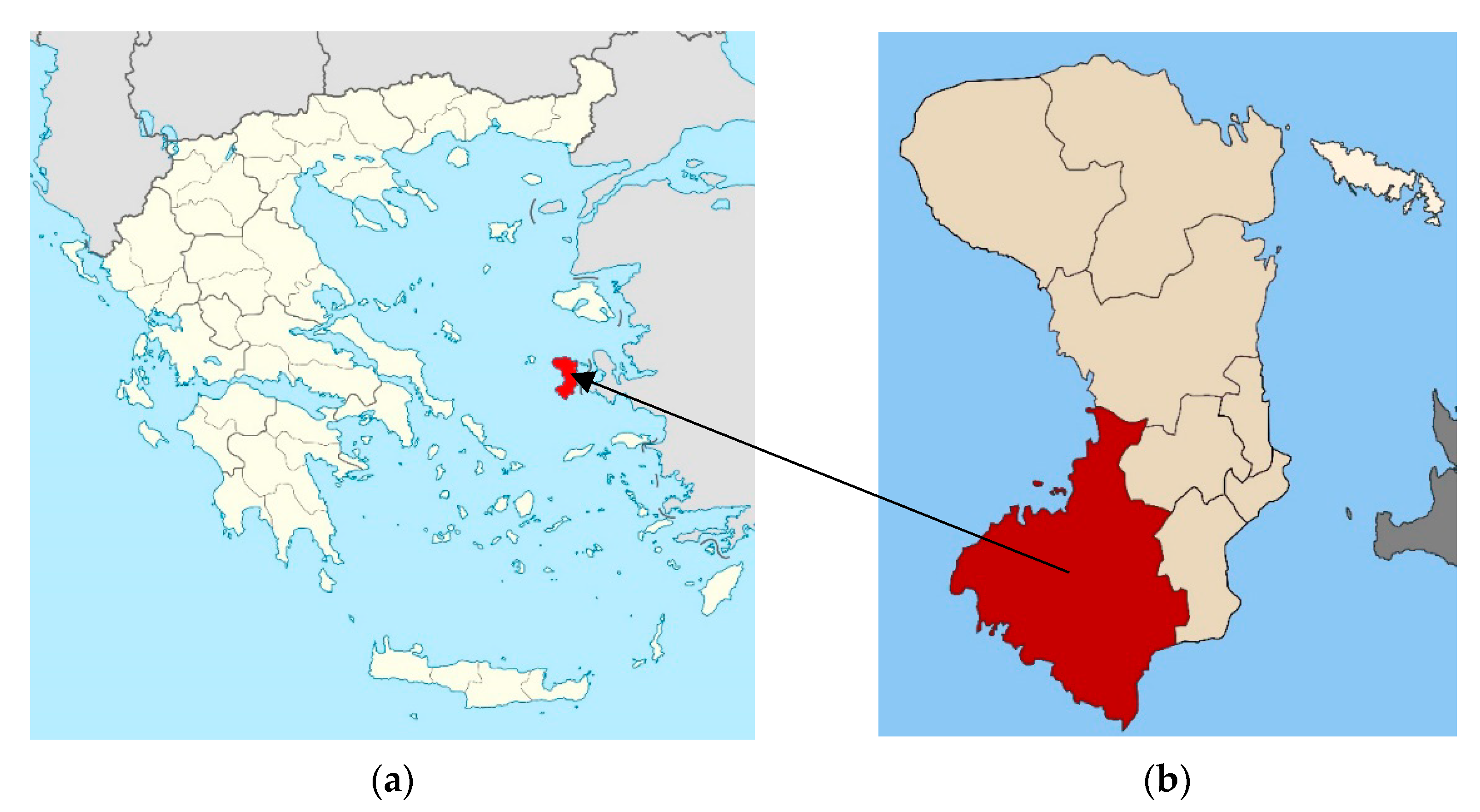
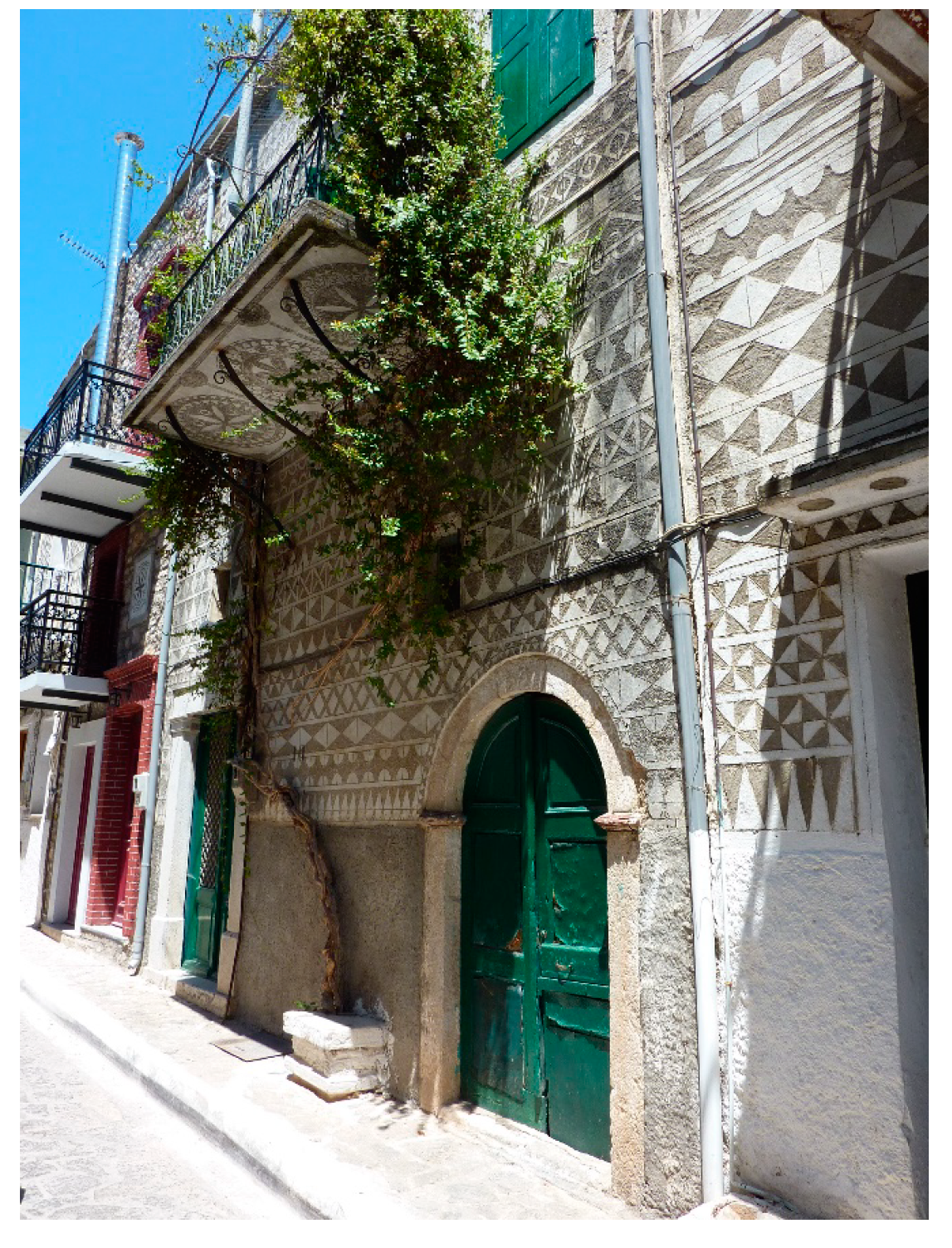
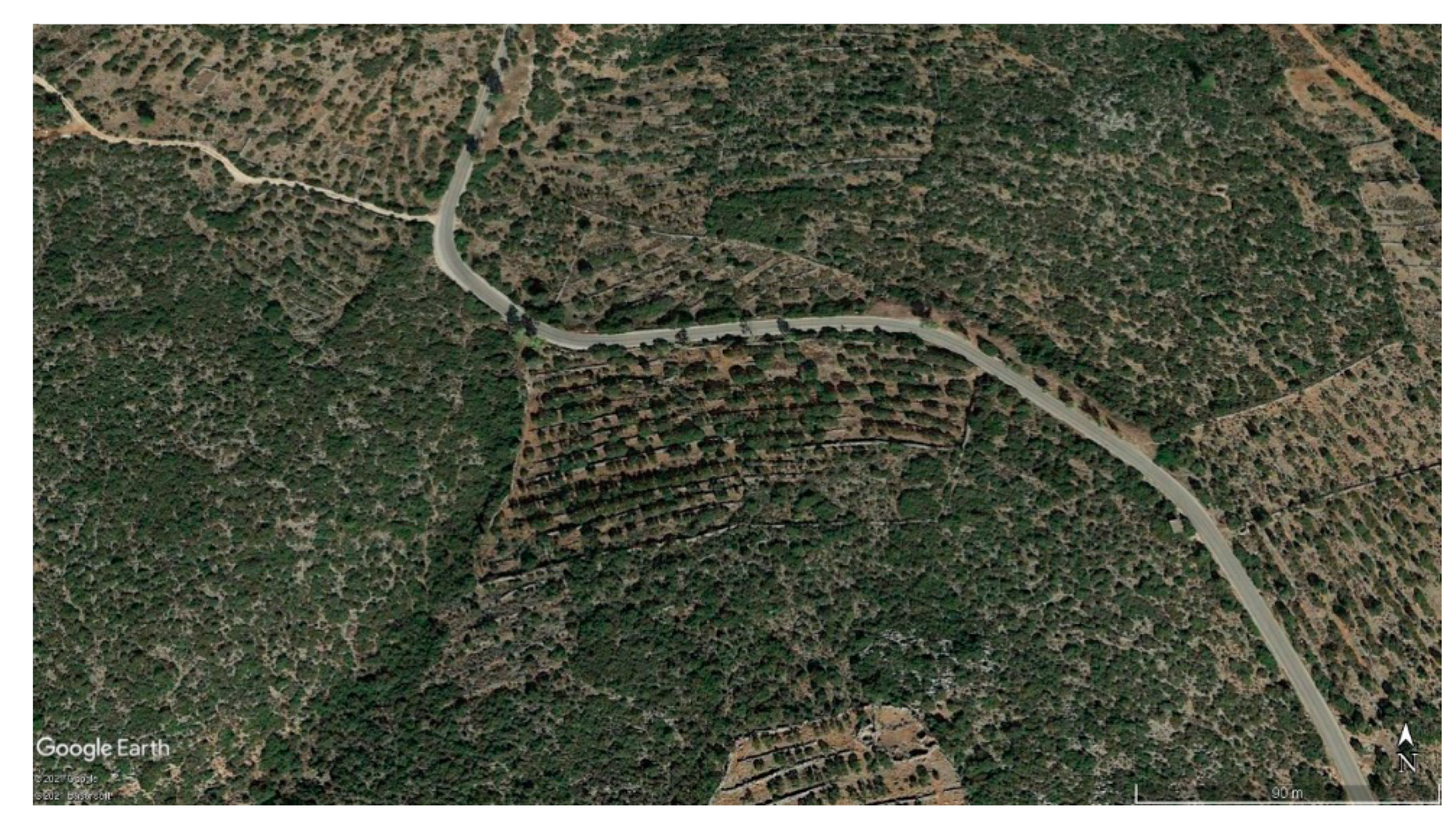
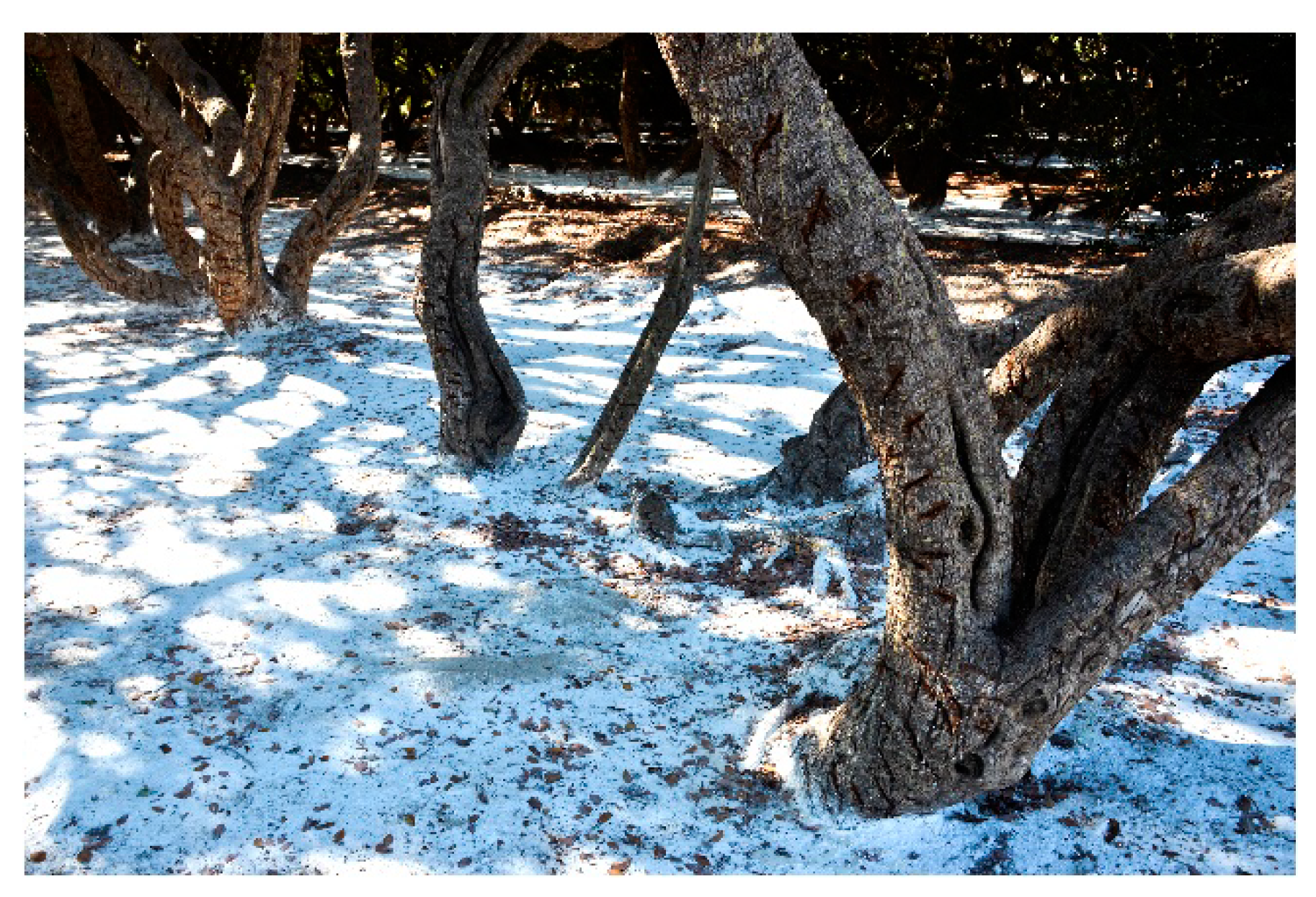
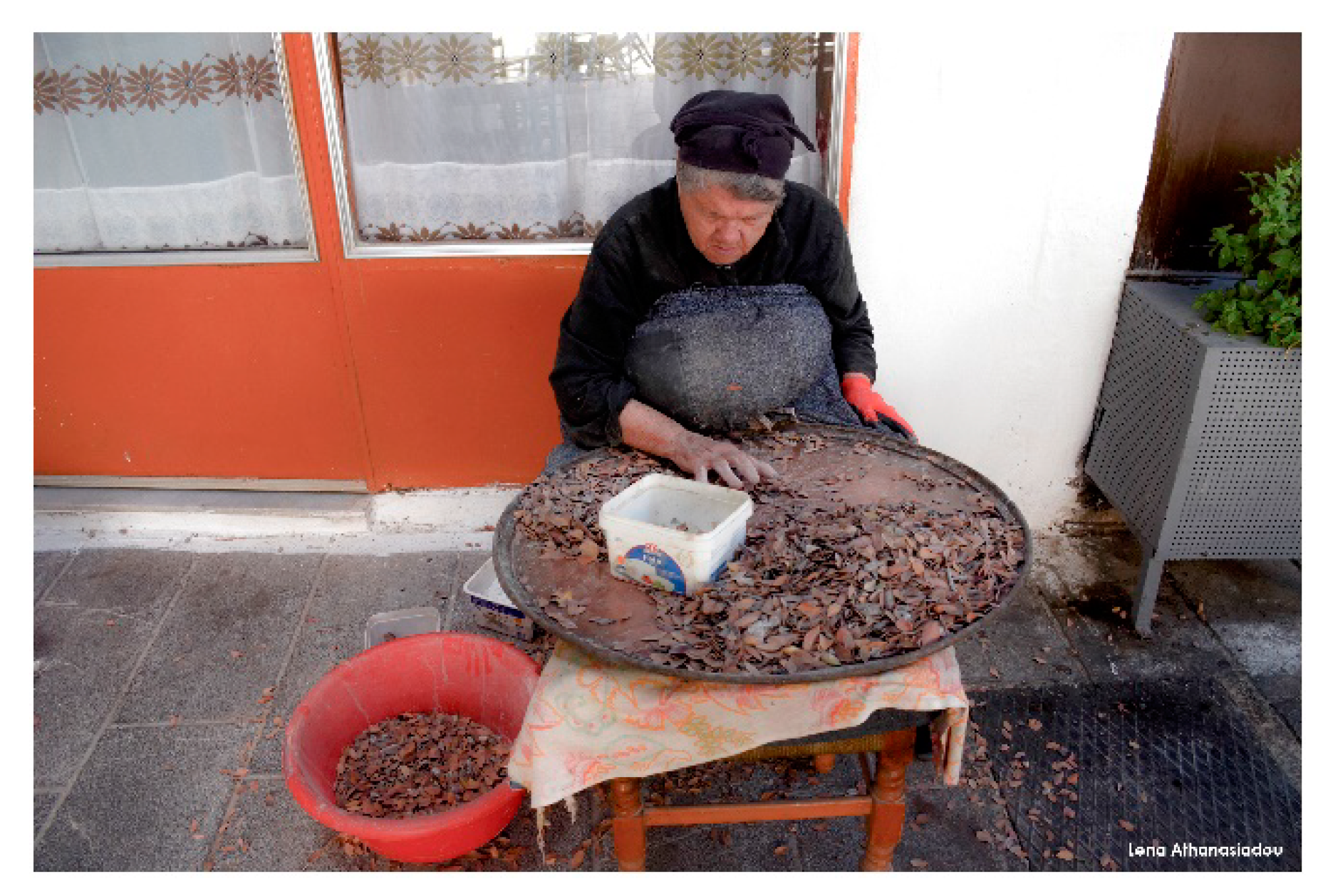
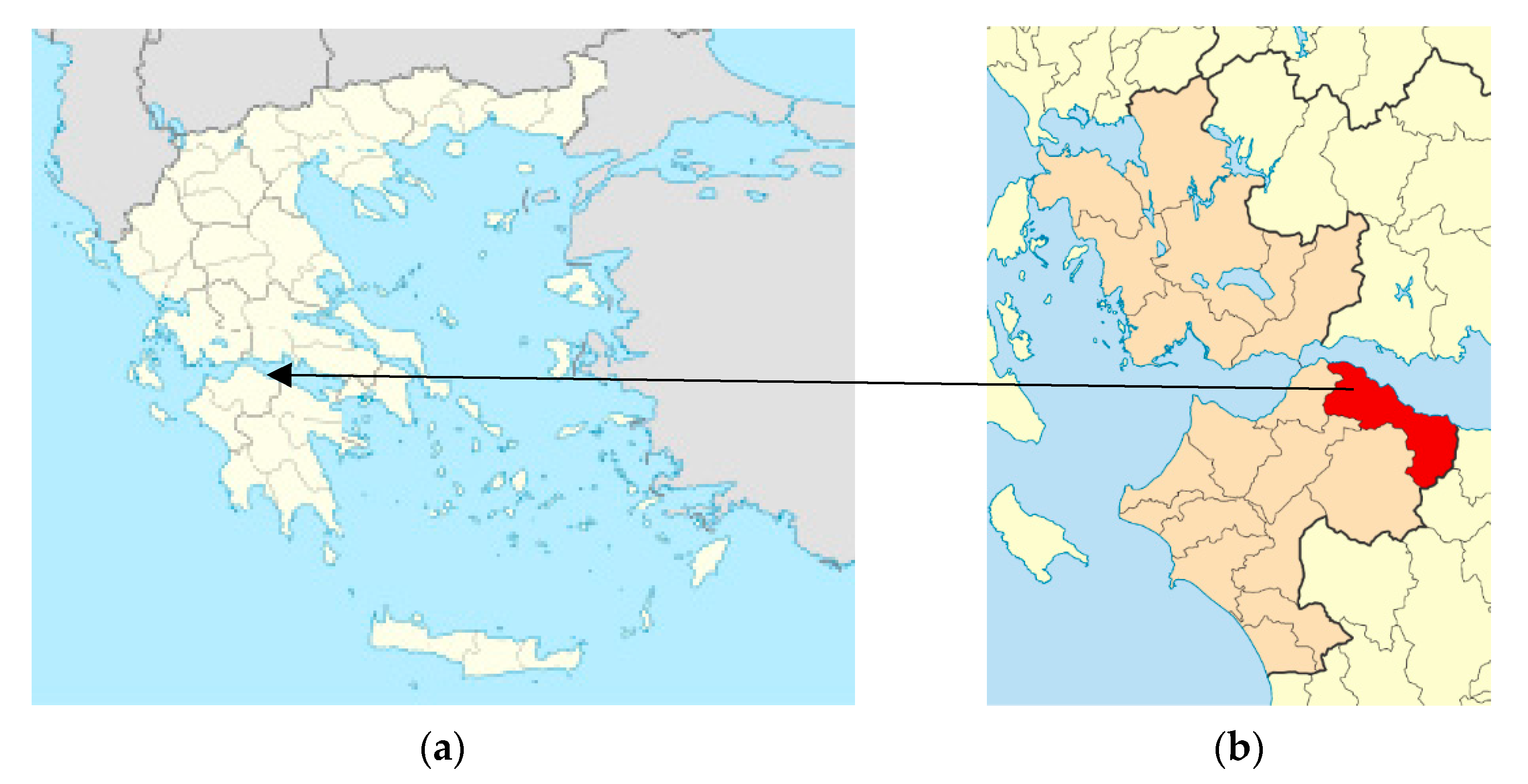
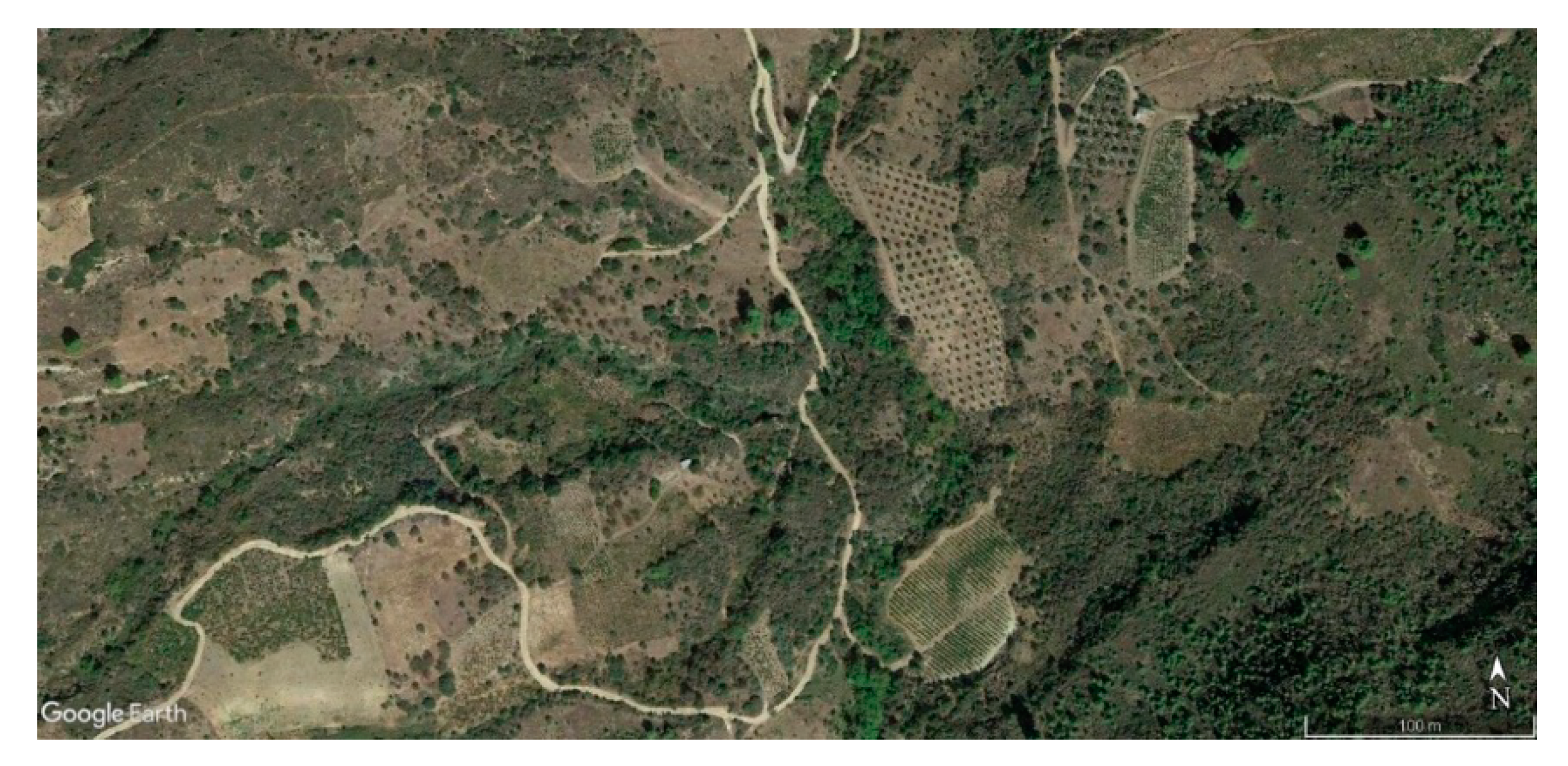
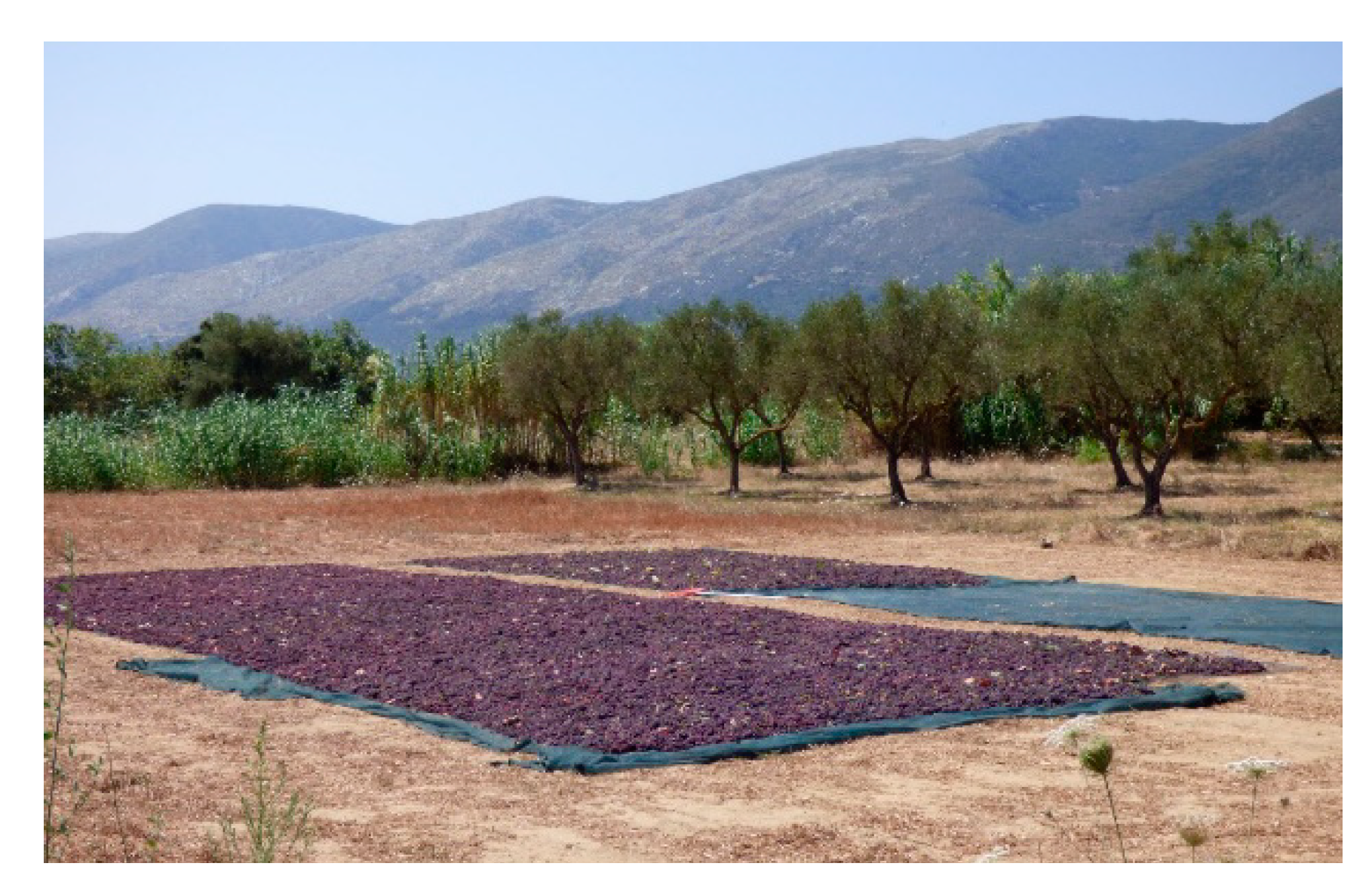
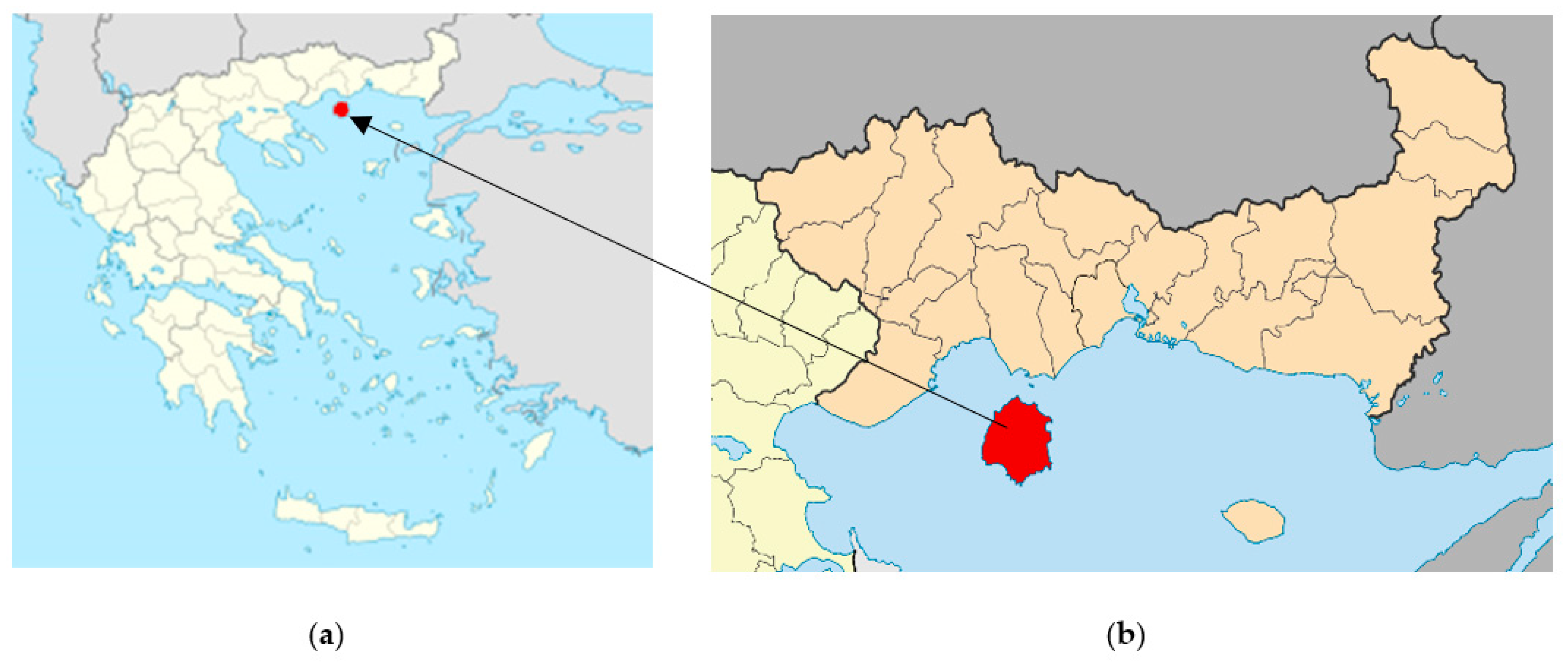
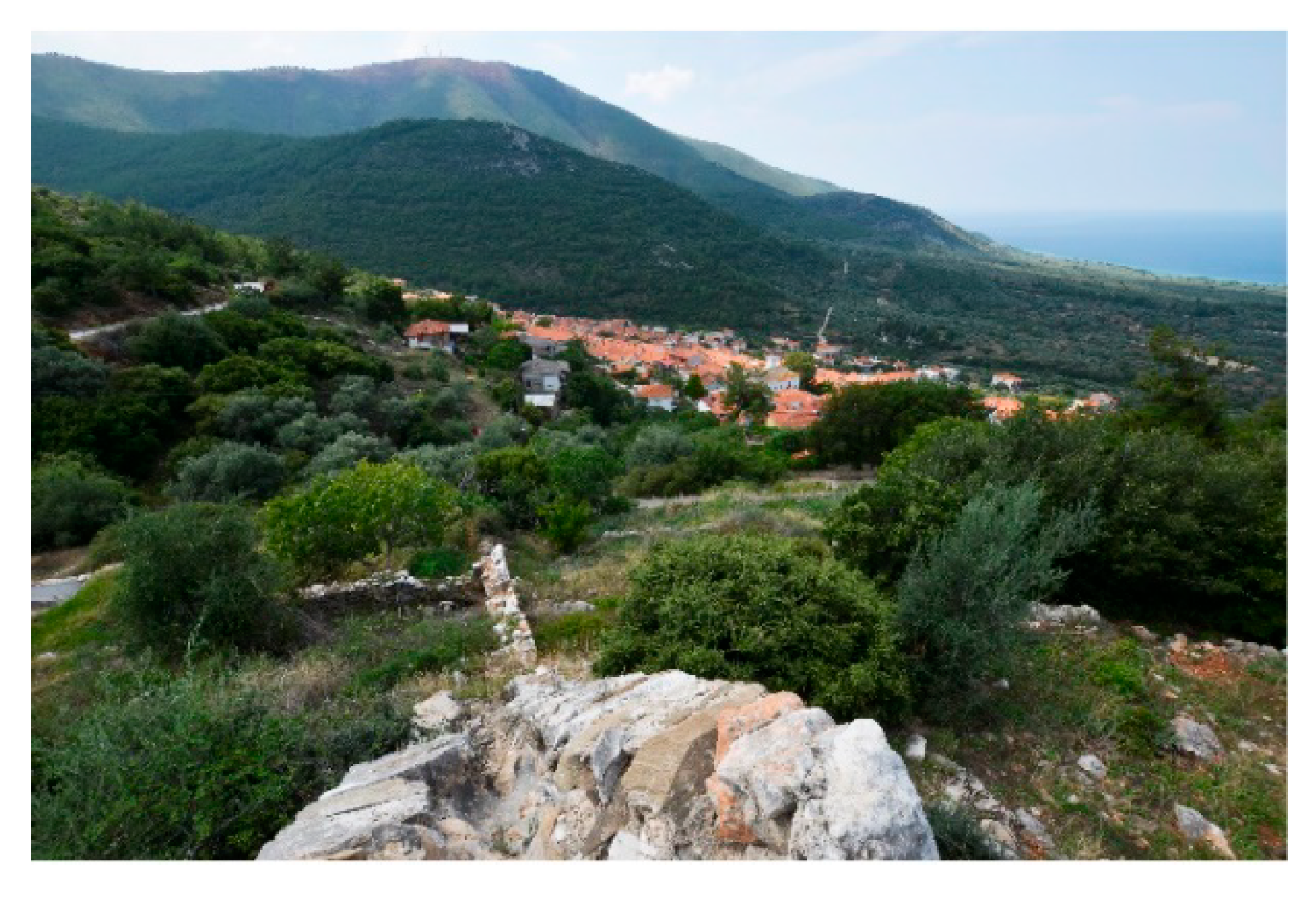
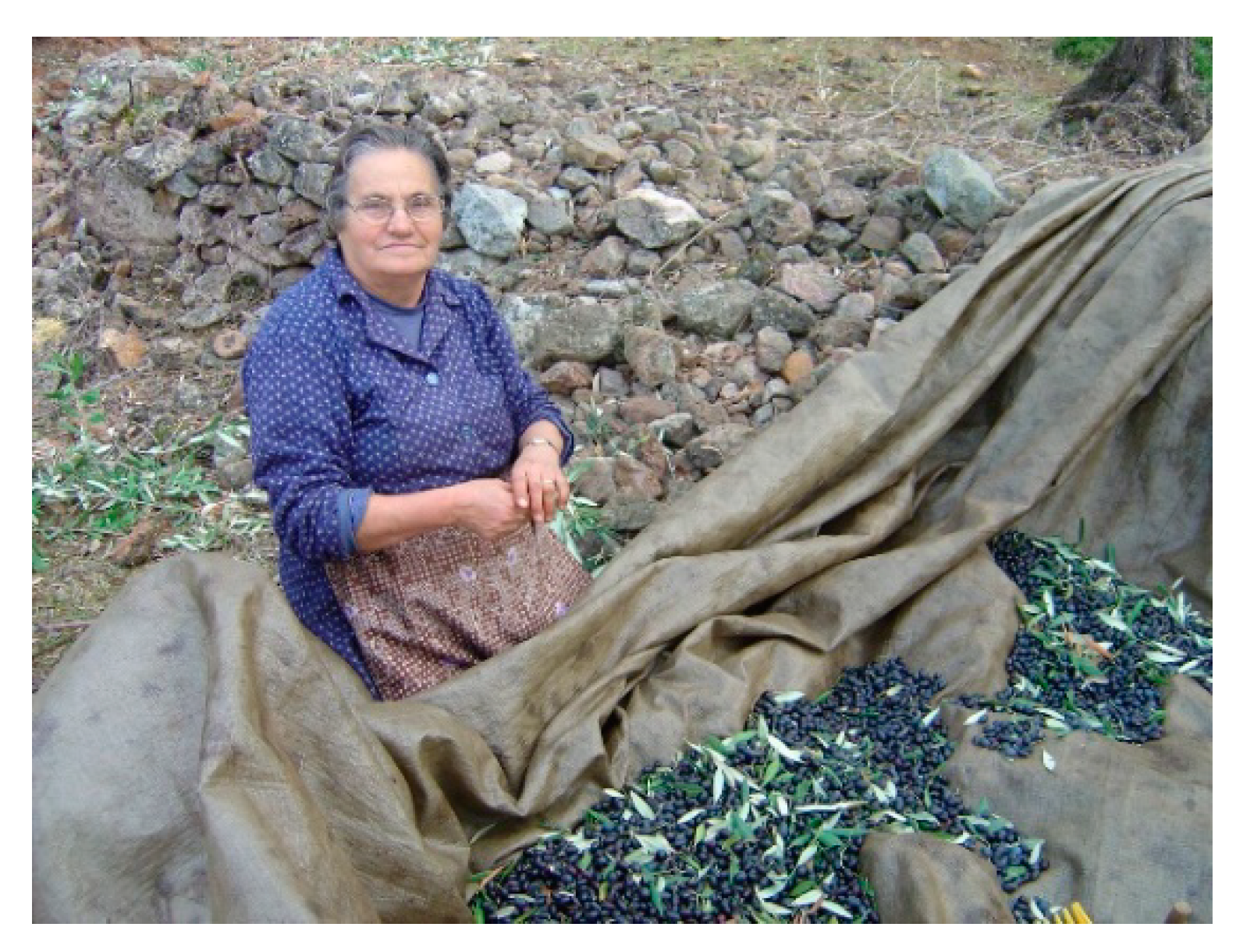
| Landscape Character Assessment Steps (The Countryside Agency and Scottish Natural Heritage, 2002; LI/IEMA, 2013) | Proposed Criteria for Acknowledgement and Conservation of Agricultural Heritage Landscapes | GIAHS Designation Criteria by FAO (FAO, 2021) | World Heritage Cultural Landscapes Categories and Criteria by UNESCO (UNESCO, 2019) |
|---|---|---|---|
| Landscape character (Characterization): “A distinct, recognizable, and consistent pattern of elements in the landscape that makes one landscape different from another, rather than better or worse.” | |||
| Morphology: Form, Scale, Enclosure, Texture, Colour, diversity, Unity, Balance, Proportion. | i. Aesthetically remarkable agricultural landscapes of exceptional aesthetic beauty and importance. | “Remarkable landscapes, land and water resources management features.” | “to contain superlative natural phenomena or areas of exceptional natural beauty and aesthetic importance.“ |
| ii. The morphological characteristics (form, shape) of landscapes and/or seascapes and their interlinkages are characterized by long historical persistence, representative culture and a strong connection with the local socio-economic systems that produced them. | - | “to be an outstanding example of a traditional human settlement, land-use, or sea-use which is representative of a culture (or cultures), or human interaction with the environment especially when it has become vulnerable under the impact of irreversible change.” | |
| iii. Diversity of spatial structure of agricultural plots | “Biodiversity and ecosystem function.” | - | |
| iv. Agricultural Infrastructure and settlements contribute to the spatial pattern of the landscape and illustrate a significant stage in national or global history. | “Remarkable landscapes, land and water resource management features.” | “to be an outstanding example of a type of building, architectural or technological ensemble or landscape which illustrates (a) significant stage(s) in human history.” | |
| Landscape character (judgement): a. Landscape quality, b. Landscape value | |||
| a. Landscape quality (condition) is based on judgements about the extent to which the distinctive character of a particular landscape character type is visible in a specific area, and about the physical state or repair of the landscape or its visual and ecological integrity (sometimes referred to as its function or condition).” | v. Dynamically evolved landscapes. The process of evolution is reflected in the form and elements and features. The condition of the landscape features and elements might be poor/declining/good. | “Globally Important Agricultural Heritage Systems (GIAHS) are outstanding landscapes of aesthetic beauty that combine agricultural biodiversity, resilient ecosystems and a valuable cultural heritage.” | “Cultural Landscapes category (ii): is the organically evolved landscape. This results from an initial social, economic, administrative, and/or religious imperative and has developed its present form by association with and in response to its natural environment. Such landscapes reflect that process of evolution in their form and component features.” “They fall into two sub-categories: - a relict (or fossil) landscape is one in which an evolutionary process came to an end at some time in the past, either abruptly or over a period. Its significant distinguishing features are, however, still visible in material form. - a continuing landscape is one which retains an active social role in contemporary society closely associated with the traditional way of life, and in which the evolutionary process is still in progress. At the same time, it exhibits significant material evidence of its evolution over time.” |
| vi. Landscapes shaped by unique, traditional distinctive agriculture and farming methods (in relation to the effective use of natural resources, adapted to the local environmental conditions) representative of a culture, which still contribute to the local economy. | “Food and livelihood security.“ | “Cultural Landscapes category (iii): is the associative cultural landscape. The inclusion of such landscapes on the World Heritage List is justifiable by virtue of the powerful religious, artistic or cultural associations of the natural element rather than material cultural evidence, which may be insignificant or even absent”. | |
| vii. Agricultural plots part of a diverse land use system. | “Biodiversity and ecosystem function.” | - | |
| viii. Agricultural landscapes with significant ecosystem services. | “Biodiversity and ecosystem function.” | “to be outstanding examples representing significant on-going ecological and biological processes in the evolution and development of terrestrial, fresh water, coastal and marine ecosystems and communities of plants and animals.” | |
| b. Landscape value (scenic beauty, rarity, representativeness, wilderness, tranquillity, existence of a consensus, associations with particular people, events in history). “The relative value or importance attached to a landscape (often as a basis for designation or recognition), which expresses national or local consensus, because of its quality, special qualities including perceptual aspects such as scenic beauty, tranquillity or wildness, cultural associations or other conservation issues.” | ix. Landscapes valued as a resource because they are rare. | “Remarkable landscapes, land and water resources management features.” | “to bear a unique or at least exceptional testimony to a cultural tradition or to a civilization which is living or which has disappeared.” |
| x. Landscapes reflecting a particular cultural identity. | “Cultures, value systems, and social organizations.” | “to bear a unique or at least exceptional testimony to a cultural tradition or to a civilization which is living or which has disappeared.” | |
| xi. To be acknowledged by the public about their importance. | “Cultures, value systems, and social organizations.” | “to be directly or tangibly associated with events or living traditions, with ideas, or with beliefs, with artistic and literary works of outstanding universal significance.” | |
| xii. To be associated with invaluable local and traditional knowledge, ingenious adaptive technology, local traditional, cultural, spiritual, religious and social initiatives (e.g., agricultural events, festivals) and traditional management systems of natural resources. | “Knowledge system and adapted technology.” | “to represent a masterpiece of human creative genius” | |
| xiii. Presence of social organisations for the transfer of agricultural culture, implementation of educational activities and practices, institutions to share and transfer knowledge and technology. | “Cultures, value systems, and social organizations.” | “to bear a unique or at least exceptional testimony to a cultural tradition or to a civilization which is living or which has disappeared.” | |
| xiv. To contain significant features of wildlife, earth science or archaeological or historic interest for in situ conservation. | “Biodiversity and ecosystem function.” | “to contain the most important and significant natural habitats for in-situ conservation of biological diversity, including those containing threatened species of outstanding universal value from the point of view of science or conservation.” “to be outstanding examples representing major stages of earth’s history, including the record of life, significant on-going geological processes in the development of landforms, or significant geomorphic or physiographic features.” | |
| xv. Remarkable landscapes under dynamic conservation | “Remarkable landscapes, land and water resources management features.” | “to contain the most important and significant natural habitats for in-situ conservation of biological diversity, including those containing threatened species of outstanding universal value from the point of view of science or conservation.” | |
| xvi. Globally significant biodiversity and genetic resources for food and agriculture and their importance for conservation | “Biodiversity and ecosystem function.” | “to be outstanding examples representing significant on-going ecological and biological processes in the evolution and development of terrestrial, fresh water, coastal and marine ecosystems and communities of plants and animals.” | |
| Category | Proposed Criteria for Management of Agricultural Landscapes Heritage | GIAHS Designation Criteria by FAO | World Heritage Cultural Landscapes Categories and Criteria by UNESCO |
|---|---|---|---|
| Landscape aspect: Resilience against change | xvii. The values of agricultural landscape heritage are retained, through a balance between people and the environment. | “Cultures, values systems, and social organizations.” | “to exhibit an important interchange of human values, over a span of time or within a cultural area of the world, on developments in architecture or technology, monumental arts, town-planning or landscape design.” |
| xviii. Capable of recovering from natural disasters and changes in ecosystems of local traditional systems | - | - | |
| xix. Mechanisms/networks that ensure that the agricultural landscape heritage is reliably inherited by future generations. | “Cultures, value systems, and social organizations.” | - | |
| Social aspect: Involvement of primary/key stakeholders | xx. Governance though dialogue and agreement among key stakeholders. | “Cultures, value systems, and social organizations.” | - |
| xxi. Participation of various local stakeholders and development of a shared vision for the future. | “Knowledge system and adapted technology.” | - | |
| xxii. In place initiatives to facilitate public participation. | “Cultures, value systems, and social organizations.” | - | |
| Legal aspect | xxiii. Laws support the maintenance of the territory potentialities and protection of landscape quality. | - | - |
| Economic aspect | xxiv. Development of alternative forms of tourism (e.g., agrotourism). | “Remarkable landscapes, land and water resources management features.” | - |
| xxv. Create a brand name for the agricultural landscape and products. | GIAHS designated agricultural systems | - | |
| xxvi. Promotion of new business model associated with the Agricultural Heritage Landscapes. | - | - |
| Proposed Criteria for Acknowledgement and Conservation of Agricultural Landscapes Heritage | Black (Corinthian) Raisin Vineyards in Aigialeia | Masticulture in Chios | Olive Groves in Thassos |
|---|---|---|---|
| i. Aesthetically remarkable agricultural landscapes of exceptional aesthetic beauty and importance. | - 1 | - | - |
| ii. The morphological characteristics (form, shape) of landscapes and/or seascapes and their interlinkages are characterized by long historical persistence, representative culture and a strong connection with the local socio-economic systems that produced them. | - | X | X |
| iii. Diversity of spatial structure of agricultural plots | X | X | - |
| iv. Agricultural infrastructure and settlements contribute to the spatial pattern of the landscape and illustrate a significant stage in national or global history. | - | X | X |
| v. Dynamically evolved landscapes. The process of evolution is reflected in the form and elements and features. The condition of landscape features and elements might be poor/declining/good. | X | - | X |
| vi. Landscapes shaped by unique, traditional distinctive agriculture and farming methods (in relation to the effective use of natural resources, adapted to the local environmental conditions) representative of a culture, which still contribute to the local economy | X | X | X |
| vii Agricultural plots part of a diverse land-use system | X | X | - |
| viii. Agricultural landscapes with significant ecosystem services | X | X | X |
| ix. Landscapes valued as a resource because they are rare | - | X | - |
| x. Landscapes reflecting a particular cultural identity | X | X | X |
| xi. To be acknowledged by the public about their importance | X | X | X |
| xii. To be associated with invaluable local and traditional knowledge, ingenious adaptive technology, local traditional, cultural, spiritual, religious and social initiatives (e.g., agricultural events, festivals) and traditional management systems of natural resources. | X | X | X |
| xiii. Presence of social organisations for the transfer of agricultural culture, implementation of educational activities and practices, institutions to share and transfer knowledge and technology | X | X | - |
| xiv. To contain significant features of wildlife, earth science or archaeological or historic interest for in—situ conservation. | X | X | X |
| xv. Remarkable landscapes under dynamic conservation | - | - | - |
| xvi. Globally significant biodiversity and genetic resources for food and agriculture and their importance for conservation | X | X | X |
| Proposed Criteria for Management of Agricultural Landscapes Heritage | Black (Corinthian) Raisin Vineyards in Aigialeia | Masticulture in Chios | Olive Trees in Thassos |
|---|---|---|---|
| xvii. The values of agricultural landscape heritage are retained, through a balance between people and the environment. | X | X | X |
| xviii. Capable of recovering from natural disasters and changes in ecosystems of local traditional systems | - 1 | X | X |
| xix. Mechanisms/networks that ensure that the agricultural landscape heritage is reliably inherited by future generations | X | X | X |
| xx. Governance through dialogue and agreement among key stakeholders | - | X | X |
| xxi. Participation of various local stakeholders and development of a shared vision for the future | X | X | X |
| xxii. In place initiatives to facilitate public participation | - | - | - |
| xxiii. Laws support the maintenance of the territory potentialities and protection of landscape quality | - | - | - |
| xxiv. Development of alternative forms of tourism (e.g., agrotourism) | - | - | - |
| xxv. Brand name for the agricultural landscape and products | X | X | X |
| xxvi. Promotion of new business model associated with the Agricultural Heritage Landscapes | - | - | - |
Publisher’s Note: MDPI stays neutral with regard to jurisdictional claims in published maps and institutional affiliations. |
© 2021 by the authors. Licensee MDPI, Basel, Switzerland. This article is an open access article distributed under the terms and conditions of the Creative Commons Attribution (CC BY) license (https://creativecommons.org/licenses/by/4.0/).
Share and Cite
Gkoltsiou, A.; Athanasiadou, E.; Paraskevopoulou, A.T. Agricultural Heritage Landscapes of Greece: Three Case Studies and Strategic Steps towards Their Acknowledgement, Conservation and Management. Sustainability 2021, 13, 5955. https://doi.org/10.3390/su13115955
Gkoltsiou A, Athanasiadou E, Paraskevopoulou AT. Agricultural Heritage Landscapes of Greece: Three Case Studies and Strategic Steps towards Their Acknowledgement, Conservation and Management. Sustainability. 2021; 13(11):5955. https://doi.org/10.3390/su13115955
Chicago/Turabian StyleGkoltsiou, Aikaterini, Eleni Athanasiadou, and Angeliki T. Paraskevopoulou. 2021. "Agricultural Heritage Landscapes of Greece: Three Case Studies and Strategic Steps towards Their Acknowledgement, Conservation and Management" Sustainability 13, no. 11: 5955. https://doi.org/10.3390/su13115955
APA StyleGkoltsiou, A., Athanasiadou, E., & Paraskevopoulou, A. T. (2021). Agricultural Heritage Landscapes of Greece: Three Case Studies and Strategic Steps towards Their Acknowledgement, Conservation and Management. Sustainability, 13(11), 5955. https://doi.org/10.3390/su13115955







